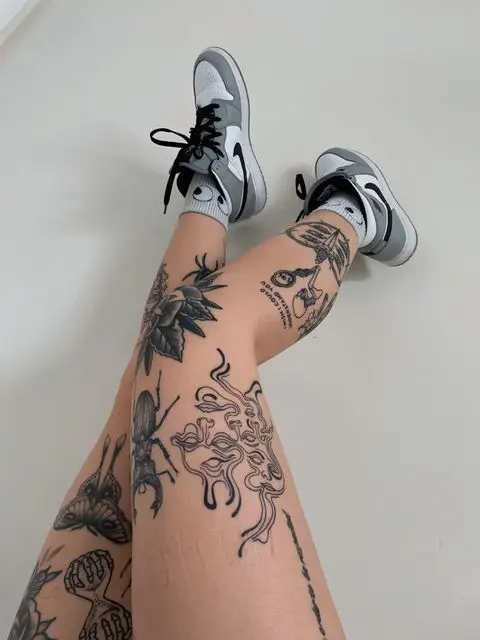Getting a tattoo can be a thrilling experience, but it’s important to know that some areas of your body are more painful than others. The most painful places to get a tattoo include areas with a high concentration of nerve endings, such as the ribs, spine, and inner biceps. Understanding where these sensitive spots are can help you better prepare for the experience.
Pain tolerance varies from person to person, so what is unbearable for one may be manageable for another. Choosing the right location for your tattoo can significantly affect your overall comfort. Exploring pain reduction strategies, such as numbing creams, can also make a difference.
As you read on, you’ll discover insights into tattoo pain, the most and least painful areas, and tips for making the process as smooth as possible.


Key Takeaways
- Certain body parts are significantly more painful for tattoos due to their anatomy.
- Pain tolerance varies greatly among individuals, influencing the tattoo experience.
- Numbing creams and other strategies can help reduce discomfort during the process.
Understanding Tattoo Pain
Tattoo pain is a subjective experience influenced by various biological and psychological factors. Recognizing these elements can help you better prepare for your tattoo session.
The Science of Tattoo Pain
Tattooing involves inserting ink into the skin with needles, which stimulates numerous nerve endings. These nerve endings send pain signals to the brain, triggering a response based on your pain threshold.
Your pain tolerance, which varies among individuals, plays a significant role in how much discomfort you will feel. Biological sex can also affect pain perception, with studies showing that women often report higher pain levels in certain situations.
Additionally, age is a factor. Younger skin generally has more elasticity and fewer sensitivities than older skin.
Factors Affecting Tattoo Pain
Several factors influence how painful a tattoo may feel to you. Body fat is one element; areas with more fat tend to have a cushioning effect, potentially reducing perceived pain.
Conversely, areas with little fat and less muscle, such as the ribs or spine, often experience more intense pain due to the proximity of bone and nerve endings.
Pain management techniques can also help. Methods like deep breathing, mindfulness, or even topical numbing creams can lessen the discomfort during the session.
Knowing your body and its specific sensitivities can aid in choosing a tattoo location and preparing for the experience.


Most Painful Tattoo Locations
Tattoo pain varies significantly based on location on the body. Certain areas are more sensitive due to factors like proximity to bone, thin skin, and high nerve density.
Bony and Sensitive Areas
Tattoos placed on bony areas tend to be the most painful. The ribcage is notorious for its discomfort, as the skin sits thinly over the bones. Getting inked along the spine can also be quite intense due to the many nerves and minimal cushioning.
Ankles and the elbow are other painful spots. Tattoos near these joints amplify pain perception as they are sensitive to movement and pressure. The hand and wrist are similarly sensitive areas because of the thin skin and high concentration of nerve endings.
Notorious Painful Spots
Regions like the neck and chest often rank high in pain levels. The neck is particularly sensitive, as it has many nerves and thin skin. Chest tattoos can be excruciating, especially near the sternum or collarbones, where the skin is stretched tightly.
While everyone’s pain tolerance varies, each of these locations is consistently mentioned by tattoo recipients. The discomfort can be amplified by factors like the tattoo needle’s depth and the artist’s technique.
Comparing Pain Levels Across the Body
A tattoo pain chart often categorizes areas by sensitivity. For instance, the ribcage and spine are at the higher end, while the upper arm is typically considered a less painful area.
Here’s a general comparison of pain levels:
| Body Area | Pain Level |
|---|---|
| Ribcage | High |
| Spine | High |
| Elbow | High |
| Neck | High |
| Chest | High |
| Hand/Wrist | Moderate to High |
| Upper Arm | Low to Moderate |
Understanding these pain levels can help you mentally prepare for the tattoo process. Prioritize your comfort by selecting the location that best aligns with your pain tolerance.
Least Painful Tattoo Locations
Certain areas of your body experience less pain during tattoo sessions due to factors like fat and muscle density. Understanding these locations can help you choose the best spot for your first tattoo or a touch-up.
Fattier and Muscular Regions
Tattoos placed on fattier or more muscular areas typically result in less discomfort. These regions provide additional cushioning, lessening the impact of the needle.
Thigh: The outer thigh has a good amount of muscle, making it a less painful option. The skin is thicker here, which provides some protection from the needle.
Calf: Similar to the thigh, the calf is muscular and has more padding. This location often enables a quicker recovery, as swelling tends to be minimal.
Upper Arm: The upper arm, particularly the outer side, tends to facilitate less painful tattoos. The muscle offers a buffer during the tattooing process, helping you stay comfortable.
Common Locations with Milder Pain
Some body locations are known for their relative pain tolerance during tattooing. You might find these options appealing if you’re concerned about discomfort.
Forearms: The forearm skin is usually not as sensitive as other areas. You will likely experience reduced pain, making it a popular choice for many.
Outer Shoulder: Tattooing on the outer shoulder often causes less pain compared to inner areas. The skin here is slightly thicker and less sensitive, which can ease the experience.
Selecting these locations can lead to a more pleasant tattooing experience with manageable levels of discomfort.


Pain Reduction Strategies
When planning a tattoo, selecting appropriate pain reduction strategies can significantly enhance your experience. Considerations around artist choice, care before and after the procedure, and practical pain management techniques can make a meaningful difference.
Choosing the Right Artist and Location
Selecting an experienced tattoo artist is crucial. Their skill level can influence how gentle the tattooing process feels. Look for artists with positive reviews and a portfolio showcasing their work.
Tattoo Placement also affects pain levels. Areas with more flesh, such as the upper arm or thigh, tend to be less painful than bony areas like the ribcage or spine. Discuss your pain tolerance and preferences with your artist to find the best location.
Pre- and Post-Tattoo Care
Preparing for your tattoo is essential. Stay hydrated to help your skin tolerate the process better. Avoid alcohol and blood thinners for at least 24 hours before getting inked, as these can heighten sensitivity.
Aftercare is equally important. Keep the tattoo clean and moisturized to prevent irritation and complications. Follow your artist’s aftercare instructions strictly, as proper care can enhance healing and comfort.
Pain Management Techniques
Utilizing numbing creams can be an effective strategy for reducing pain. Apply a topical anesthetic an hour before the tattoo to minimize discomfort. Always consult your artist about safe and suitable options.
During the tattooing process, consider practicing deep breathing or listening to music to distract yourself. You might also discuss breaks with your artist if you need a moment to regroup. Managing your comfort during the tattoo can lead to a more positive experience.
- 80shares
- Facebook0
- Pinterest80
- Twitter0


